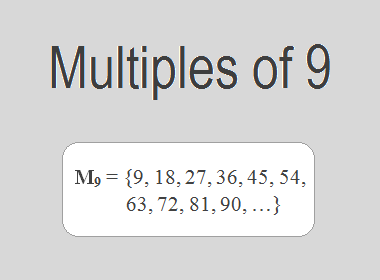
The Multiples of 9
are 9, 18, 27, 36, 45, 54, 63, 72, 81, 90, … i.e. M9 = {9, 18, 27, 36,
45, 54, 63, 72, 81, 90, …}. Multiples of 9 are the series of numbers obtained
by multiplying 9 with the natural numbers.
9 × 1 = 9
9 × 2 = 18
9 × 3 = 27
9 × 4 = 36
9 × 5 = 45
9 × 6 = 54
9 × 7 = 63
9 × 8 = 72
9 × 9 = 81
9 × 10 = 90
…
And so on.
From this series, we observe that the multiples of 9 can be
derived by multiplying 9 by natural numbers in ascending order. These multiples
form an arithmetic sequence with a common difference of 9.
Properties and Patterns of Multiples of 9
Multiples of 9 possess several interesting properties and
patterns that make them unique. Here are a few notable ones:
1. Divisibility: One of
the fundamental properties of multiples of 9 is their divisibility. A number is
a multiple of 9 if and only if the sum of its digits is divisible by 9. For
example, 36 is a multiple of 9 because 3 + 6 = 9, which is divisible by 9. This
property holds true for all multiples of 9, allowing for quick divisibility
tests.
2. Cyclical Pattern: The
units digit of multiples of 9 follows a cyclical pattern: 9, 8, 7, 6, 5, 4, 3,
2, 1, 0. This pattern repeats indefinitely, demonstrating the consistent nature
of multiples of 9. For instance, 18, 27, 36, 45, and so on, all have a units
digit of 9. This pattern can be useful in identifying the units digit of large
multiples of 9.
3. Relationship with Other Multiples: Multiples of 9 have interesting relationships with multiples
of other numbers. Since 9 is a multiple of 3, any multiple of 9 is also a
multiple of 3. Similarly, if we multiply 9 by any whole number, the result will
be a multiple of that number. These relationships allow for exploring
connections between multiples and discovering mathematical patterns.
4. Multiplication by Powers of 10: Multiplying a multiple of 9 by powers of 10 reveals an
intriguing property. When you multiply 9 by 10, the result is 90, which is a
multiple of 9. This pattern extends to higher powers of 10 as well. For
example, multiplying 9 by 100 gives us 900, again a multiple of 9. This
property holds true for any power of 10, emphasizing the relationship between
multiples of 9 and powers of 10.
********************
10 Math Problems officially announces the release of Quick Math Solver and 10 Math Problems, Apps on Google Play Store for students around the world.
********************
********************
Applications of Multiples of 9
The study of multiples of 9 finds applications in various
fields, including mathematics, science, and everyday life:
1. LCM: One of the
applications of multiples of 9 is in finding the lowest common multiple (LCM)
of two or more numbers. The LCM is the lowest multiple that two or more numbers
have in common. For example, to find the LCM of 9 and 6, we need to find the multiples
of both numbers and identify the lowest multiple they have in common. The multiples
of 9 are 9, 18, 27, 36, 45, 54, 63, 72, 81, 90,
… etc. The multiples of 6
are 6, 12, 18, 24, 30, 36, 42, 48, 54, 60, … etc. The lowest multiple
that they have in common is 18. Therefore, the LCM of 9 and 6 is 18.
2. Mental Math and Calculation Tricks: Understanding the properties of multiples of 9 allows for
mental calculation tricks and shortcuts. Utilizing the divisibility rule, where
the sum of digits is divisible by 9, mental multiplication and division by 9
become easier and quicker. These mental math techniques can be beneficial in
everyday calculations, saving time and improving number sense.
3. Divisibility Tests: The
divisibility rule based on the sum of digits of multiples of 9 is a valuable
tool for performing quick divisibility tests. It finds applications in various
areas, including mathematics, accounting, and finance, where divisibility plays
a crucial role in determining factors, simplifying fractions, or verifying
calculations.
4. Puzzle Solving:
Multiples of 9 are often used in puzzles and brain teasers. Sudoku puzzles, for
example, frequently incorporate multiples of 9 in their grids, contributing to
the challenge and logical reasoning required to solve them. Multiples of 9 can
also be found in number sequence puzzles and riddles, stimulating critical
thinking and problem-solving skills.
5. Mathematics Education:
Multiples of 9 serve as excellent teaching tools in mathematics education. They
provide opportunities to explore concepts such as multiplication, division,
patterns, and divisibility rules. By engaging with multiples of 9, students can
strengthen their understanding of number properties, develop problem-solving
strategies, and enhance their overall mathematical fluency.
6. Mathematical Patterns and Research: Studying the patterns and properties exhibited by multiples of
9 contributes to mathematical research and exploration. Researchers analyze
these patterns to uncover new insights into number theory, sequences, and
algebraic structures. Multiples of 9 serve as a starting point for
investigations into recurring decimals, modular arithmetic, and more.
Conclusion:
The Multiples of 9 are the numbers obtained by multiplying 9 with natural numbers. The multiples of 9 are 9, 18, 27, 36, 45, 54, 63, 72, 81, 90, … etc. The multiples of 9 have various properties, such as divisibility, cyclical pattern, relationship with other multiples, multiplication by powers of 10, etc. The multiples of 9 have several applications in mathematics, such as finding the LCM, mental math and calculation tricks, divisibility tests, puzzle solving, mathematics education, and mathematical patterns and research.



0 comments: